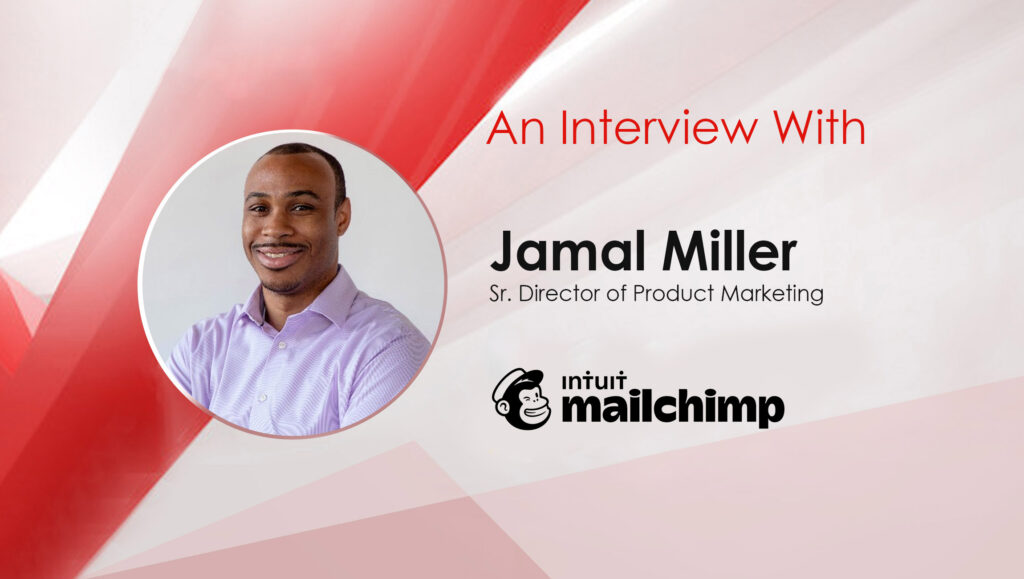Jamal Miller, Sr. Director of Product Marketing at Mailchimp shares a few segmented marketing tips and best practices in this quick chat with MarTech Series:
_________
Welcome to this MarTech Series chat, Jamal, tell us about your marketing journey through the years and the biggest B2B marketing takeaways you’ve come away with through this time…
I currently serve as Senior Director of Product Marketing at Mailchimp, responsible for aligning our product roadmap and offering to customer needs across stages of business growth— from those just starting out all the way to scaling businesses. My background in digital marketing strategy and technology comes from a range of experience across SaaS, hardware, digital services and non-profit industries for business and consumer audiences.
Over the course of my career, a couple of B2B marketing takeaways come to mind. First, B2B marketers have a similar challenge to B2C marketers. Although you are selling into a business, ultimately you need to generate awareness, consideration and adoption with individuals within an organization. So, what does that mean?
For one, brand-building can play just as important a role in driving B2B business success as it does in B2C. B2B businesses often treat brand marketing as an afterthought, but what my time at Mailchimp has taught me is that building a brand that resonates with the individuals who make buying decisions can be a key differentiator.
In an environment where many B2B companies rely heavily on the product or service offering to differentiate themselves, creating a strong brand affinity can be an advantage. Second, a strong segmentation strategy that accounts for individual preferences and personalization is key to success, whether you are in the B2B or B2C space. Understanding your personas and being intentional about customizing your marketing strategy to them is vital. Luckily, there are martech solutions to help make that task scalable.
Marketing Technology News: MarTech Interview With Vijay Chittoor, Co-founder and CEO, of Blueshift
What according to you make for some fundamental product marketing best practices that often, B2B marketers still don’t get right?
Most marketers recognize the importance of understanding their target audience, but it takes consistent examination and analysis of engagement to get this right. Consumer behavior is constantly changing, new trends emerge and preferences shift. Marketers lean on their target audiences’ behavior to guide content creation, messaging and communication channels, and if they lack a deep understanding of their audience, or audiences, it will show in their engagement.
Consumers are inundated with content, which means it’s important to make every effort to personalize your marketing. To achieve tailored marketing at this level, marketers need to lean into the data and segment their audiences. On average, segmented email marketing campaigns result in 23% higher open rates and 49% higher click‑through rates than unsegmented campaigns.
With the right information, marketers can deliver relevant, data-backed content to segments and personas within their customer base. Mailchimp allows users to segment audiences by purchase behavior, website engagement, email campaign engagement, demographic, and so much more. Once marketers have a deep understanding of their audiences’ preferences, interests and needs, they can then create a deeper connection with each customer with tailored marketing that drives conversion and increased revenue.
We make it easy for marketers to ask their customers what they want, too. Mailchimp’s Preference Center is a stand-alone landing page that gives a business’s customers the ability to update their own profile preferences. Mailchimp users can give their audiences options to customize how often they receive marketing messages, or about what topics, and even allow subscribers to opt in or out of specific campaigns.
Honeywell Biscuits, a small eCommerce bakery, used this tool to deepen their customer connections and improve their marketing. Honeywell built out its Preference Center to provide a space for subscribers to opt out of any holiday-specific emails and event-driven promotions that could spark difficult emotions, i.e. choosing to opt-out of a Mother’s Day email campaign while dealing with the loss of a parent. After receiving such a positive response from its subscribers, Honeywell expanded the use of its Preference Center to allow customers to include their name, birthday, and even a photo of themselves that populates into a designated profile for each subscriber. These details create the opportunity to establish a relationship with each customer with every email they send. While this is a B2C example, there is an opportunity for B2B marketers to explore similar ways to build more meaningful relationships that create brand affinity with prospects and customers.
We’d love to dive into your product growth and marketing strategy and also a little bit about the martech that helps drives your goals?
We are constantly looking for ways to improve the user experience by removing friction from the top of the marketing funnel all the way into the product. Our product growth and marketing strategies largely focus on this. We’re exploring new ways to make it easier for prospective users to explore what we offer, and for users to quickly be able to delve into the most valuable elements of the platform for their business needs.
This full-funnel approach to building out the experience obviously requires tight collaboration across our Product, Marketing, Web, Engineering, and Design teams among others. That said, the tools in our tech stack that enable our teams to collaborate with transparency and efficiency are quite valuable to our goals. Tools like JIRA, Workfront, Slack, and Zoom keep our teams connected and aligned on how we’ll reach our goals.
Marketing Technology News: Why 2022 Will Be The Age Of Experimentation For Marketers
Closer home, at Mailchimp, how have recent platform enhancements helped enable better end user experiences; what can users expect from the platform down the road?
From releasing new products and updating features, to making improvements to our sign in flow, we’re always thinking about how to make it easier for our customers to get more done and grow with Mailchimp.
We want growing businesses to understand more about their customers and tap into a well of marketing engagements to make data-informed decisions. We’ll continue to focus on tools that help our customers grow their business and have invested in our automations and data-backed marketing tools like Customer Journey Builder, Smart Recommendations, and Advanced Segmentation to help our customers get more targeted, personalized emails out in less time.
Looking ahead, we continue to explore ways to provide insights to help our users improve their marketing. Given the current consumer climate regarding data privacy, and a cookieless future for marketers, channels like email marketing and automations that leverage first-party data will become even more valuable. Email marketing still has one of the highest ROIs of any marketing channel. Mailchimp has been fortunate to have a long history of helping businesses globally grow through email marketing. With over 13 million users around the world, we’ve been able to see what makes for high-performing email marketing through the billions of emails sent through our platform. And so, much of the focus for us is putting that knowledge back into the hands of our users in various ways. We’ve recently launched features such as Content Optimizer, which analyzes user email campaigns and provides recommendations for how to make them more engaging based on top-performing campaigns from their industry. We’re excited for features like this and more to provide our users with data-backed insights to help them meet their goals.
Some last thoughts, marketing/martech/ digital commerce takeaways, before we wrap up!
Don’t forget to listen to your customers, especially when it comes to their pain points with using your platform. Users can provide a unique perspective to product development, but are not often consulted when it comes to the actual development of new or updated features. Gathering insight from those using your service day-to-day will provide clarity on the nuances of its functionality, potential use cases and areas of improvement. At Mailchimp our motto is to listen hard, change fast, and we outlined distinct strategies for implementing customer-influenced product development in hopes of building the best-serving technology.
Jamal Miller is the Senior Director of Product Marketing at Mailchimp.
Missed The Latest Episode of The SalesStar Podcast? Have a quick listen here!
Episode 133: B2B Customer Engagement Best Practices with Myles Kleeger, President and Chief Customer Officer of Braze
Episode 132: Biggest B2B Sales Learnings with Astrid Boer Masle, VP of Sales, EMEA & APAC – RFPIO
Episode 131: Product Management Tips and Best Practices with Kimen Warner, VP of Product Management at Drift

























